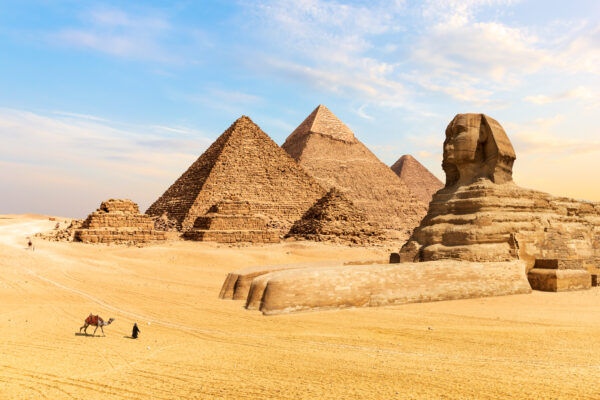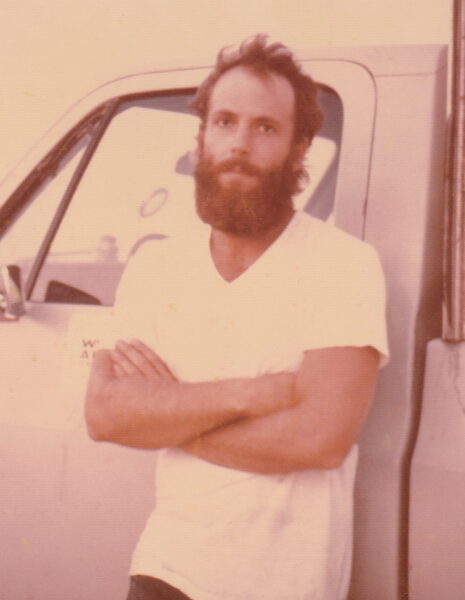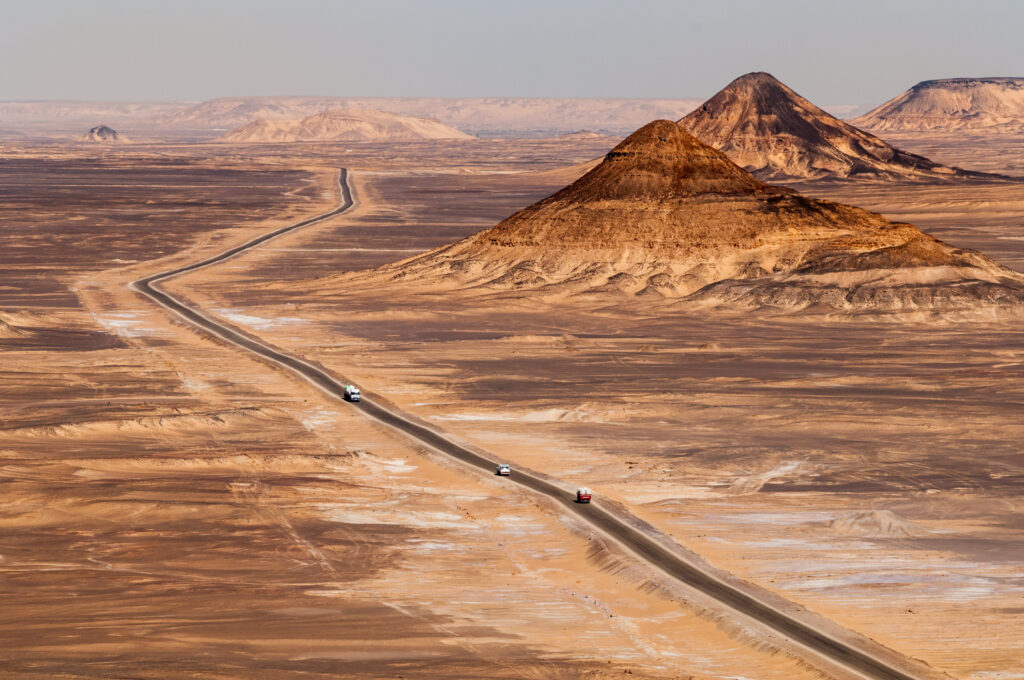The car with its nose in front has the right-of-way.
Green means stop, red means go
We drove out of Cairo early Monday morning with the dusty city swarming with agitated drivers cramming eight lanes of cars into the four normal stripped lanes. People and cars were everywhere, pointing in all directions, at a standstill, horns blaring, EVERYBODY playing chicken. Menacing stares silently exchanged, unspoken threats hinted…. You think you’re gonna get ahead of me, brother?
We drove West, so we didn’t get to drive by the Giza Pyramids. I was a little disappointed at the time. It was only when I went there a few weeks later, on my first break, that I was truly disappointed AND amazed.
The small area of the Giza Necropolis, with its iconic pyramids, receives nearly 15 million visitors a year. That’s 41,000 per DAY! It’s like being in a crowded elevator, except there’s a blazing hot sun and lots of camels. It’s impossible to move six inches without being accosted, “Sahib, camel ride?” “Sahib, pyramid tour?” “Sahib, Sphinx photo?”
The Giza Pyramids and Sphinx – a mystical moment

If you turn your back to all the crazy nightclubs, 5-star hotels, and restaurants, put your phone in your pocket for a second, and look out in a narrow field of view at just the empty desert, with the pyramids before you and the Sphinx ready to pounce any moment – it is an incredible feeling. The force is palpable. You FEEL something unique.
One thing I recognized, standing there taking this wonder of the world in, is that all the architects and builders who built the pyramids at Giza are long gone! During the 70s, chaotic dysfunction was the norm in Egypt. Everything was broken or on the verge – like all the big clocks on most buildings – frozen in time from decades past.
The Sahara commute
On my first trip out to the camp, into the desert we turned left at a landmark which was completely indistinguishable to me at the time. Far off in the distance, shimmering through the heat waves, I could just make out a line of rocky cliffs that the crew called the escarpment or the scarp.
I would become quite familiar with the scarp later on, but for now, we bumped along the hard-packed sand road while I took in the view. Somewhere in the back of my head, I was thrilled.
Welcome home!
After an hour, far off in the distance, I could see a tiny cluster of small, white trailers circled up in a defensive formation like covered wagons the original settlers used to cross the prairie in the 1800s. The camp seemed tiny in the vast emptiness of the Sahara.
Not far from the covered wagons stood a huge canvas circus tent, now a dirty khaki color. As far as I could tell, this is where all the Egyptians lived while they were in camp. They had their own separate kitchen and bathroom facilities that I never once saw.
For the ex-pats, who were Americans, Canadians, and Italians, there were two sleeping trailers. There was also one trailer each for the office, mechanic, and electronics shop, hot showers and toilets, and a kitchen and dining area. The trailers had AC and regular electricity thanks to a generator that ran 24/7 while the camp was stationary.
We had all the comforts of home – AC, heat, laundry done somewhere…(?), dining galley with benches, refrigerators, stoves, ovens – and a fairly good cook. When the cook got off work and was back sleeping in the Egyptian’s tent, the Italian mechanics would whip up some midnight carbonara for the overworked mechanics and surveyors. YUM!
ALL work, NO play
It seemed like all we did was work, eat, and sleep for the three weeks we were on (working), out in the desert or in the office before our one week off. I later found out that our company had quoted a low price to the Brazilian oil company we were contracted to while in Egypt. Hence, we were always understaffed – and working!
Most nights after dinner, the surveyors would go back to work, turning their notes and numbers from that day into locations, elevations, reference numbers, and lines on big maps. The unrelenting pace of the work was intense – night after night after night, day after day, waiting three weeks for your blessed Seven Days Off.
Because of the pace and mental overload, the head surveyor, a quirky small guy from Canada, would be calculating numbers and drawing lines on the map while occasionally saying “FAAAAAAAACCK!!!,” like he was talking to himself. It expressed everyone’s mood about our situation and would always make me smile and chuckle to myself.
In the beginning, the whole thing was an adventure for me. This, I knew was not my true life’s work. I was on an adventure, so the long hours were just part of the journey. I am in EGYPT, I kept thinking to myself!
It’s 7:00 AM – Off your ass, onto your feet. Out of the shade, into the heat!
Our work day usually started around 6:00 AM, getting up, using the shower/toilet trailer, having breakfast, grabbing a snack lunch, and heading to the trucks.
Along the way, we would all grab a couple armfuls of survey stakes from under one of the trailers, shake the fat yellow scorpions off them, and throw them in the trucks.
It was somebody’s job to write reference numbers on the pointy ends of the stakes so the numbers would be buried and not obliterated by the sun and wind.
Now, where are we, exactly?
If we were working in a new area, we would need to triangulate our position so we could place ourselves accurately on our maps later. This could sometimes be a complex process, as the regular Trig Stations, small monuments to help future surveyors of all kinds locate themselves, had all been blown up by the Egyptian army. They had been seen as risky due to the Israeli conflict.
On most days, we returned to an area we had been working in for a few weeks. We would drive up to where we had left off the previous day, and the Egyptian crew would hop out. They would grab the stakes with the correct numbers, the 100’ chain, and take off walking while we leveled and oriented our instrument.
When the guy walking in front felt the chain go tight, he would turn around, and we would wave or point or sometimes gesticulate wildly, left or right, if he was far away, until he knew exactly where to pound in the stake. And off they would go until our lunch break or until we reached the end of that line, as designated by our client’s contract.
It’s Ramadan! NO food. NO WATER. Walking in the desert, sun up to sundown!!
Ramadan was close to inhumane for our crew. Every single Muslim on our crew, that’s all the Egyptians, would fast (no food, no water) from sunrise to sunset. Before and after sunup and sundown, they were eating and drinking as much as possible! Every night sounded like a party coming from the big tent!
Fortunately for all of us, Egypt is not super hot! Where I grew up in Dallas, Texas, is much hotter! Egypt’s high temps, around 95 F degrees, felt warm, but there was almost always a light breeze, plus very low humidity. A pleasant summer day by Texas standards, which can regularly see 110 F or 115 F in the summer.
Walk till the chain is tight, pound in the stake, pick up the chain, and keep walking. 8 hours. No water. Or food.
I’m pretty sure, from the wild, disoriented look in the crew’s eyes by 5:00/5:30 PM that September, that they were all hallucinating. I can vividly recall the tall bedouin’s lips caked with a white dried paste – probably salt.
That kind and gentle man was my first exposure to true, rock-solid toughness. Plus, he was renowned for his eyesight, which many Bedouins have to survive in the desert. He could spot tracks on a small hill miles away.
Dinner time, our workday is half over!
Coming back into camp, we would bring in our theodolite and papers and notes and set them in the office while we showered and had dinner. Then it was back to work. Another 4-5 hours, usually getting to bed around 11:30 or 12:00 midnight. Quite often, after we had devoured the Italian’s carbonara.

Once in a while, we would actually be done with office work early, and on those rare nights, I would grab a blanket and go walking out into the darkness till I couldn’t hear the generator over the breeze. Sometimes, I would sit and do nothing, just breathe and feel the desert.
On one of those times, sitting way out in the sand, a large flock of birds flew directly over my head in the dark. It was a sudden sound of wings rushing straight at me, and then – whoosh! – they were past me and gone in a second.
It was one of many experiences which I have never forgotten – like the low, yellow full moon, rising slowly over the lesser, unknown pyramids next to one of our many campsites. Wow! It always felt otherworldly!
Life deep in the desert – flies, sand storms, and guns
There were many wild and mysterious moments traveling way out in that seemingly lifeless landscape.
For example, where did all the FLIES come from? We would be doing our work, 100’ forward at a time, and would need to move the trucks and set up to go further, and suddenly, BOOM! We were swarmed by flies, very thirsty houseflies.
It was a sight that would become familiar: a dozen or so flies around everyone’s eyes until we pulled our shirts up over our foreheads to keep the flies out.
Then there were the sand storms. Yes, they really do look like that! Imagine a 70’ wave at the Maui Jaws surf break – but it’s made of sand. It’s coming at you and it’s moving fast. We just packed up and made a dash for camp!
Who goes there? Held at gunpoint.
One of the wilder days at work in the desert was the day we stumbled across a Secret military base. Secret, because we had no idea it was there, and they had no idea we were there – we were quickly looking down the barrels of a few combat rifles.
The small regiment, or whatever they were, looked like they had just woken up from their nap. A few didn’t have their bootlaces tied – they just jumped off their cots and came running out to see what was going on!
Fortunately, we did have two trained crew members who were Egyptian. They knew how to use the theodolite, and do some of the office work, calculating elevations, altitude levels, and more. They were able to calm down the troops who were so bored, they were probably hoping that they were being invaded!
Finally, they were able to talk to their commanding officer via radio, and the commander was able to contact a general or somebody who told them to let us go. By then, it was almost dark, and finding our way back to camp required the bedouin’s help and driving slower than normal.
Working in the sand and rock of the desert was easy compared to the farmland
Seismic surveying in the agricultural areas was complex and slow. A whole new set of challenges. Poverty like I have never seen since, for one.
